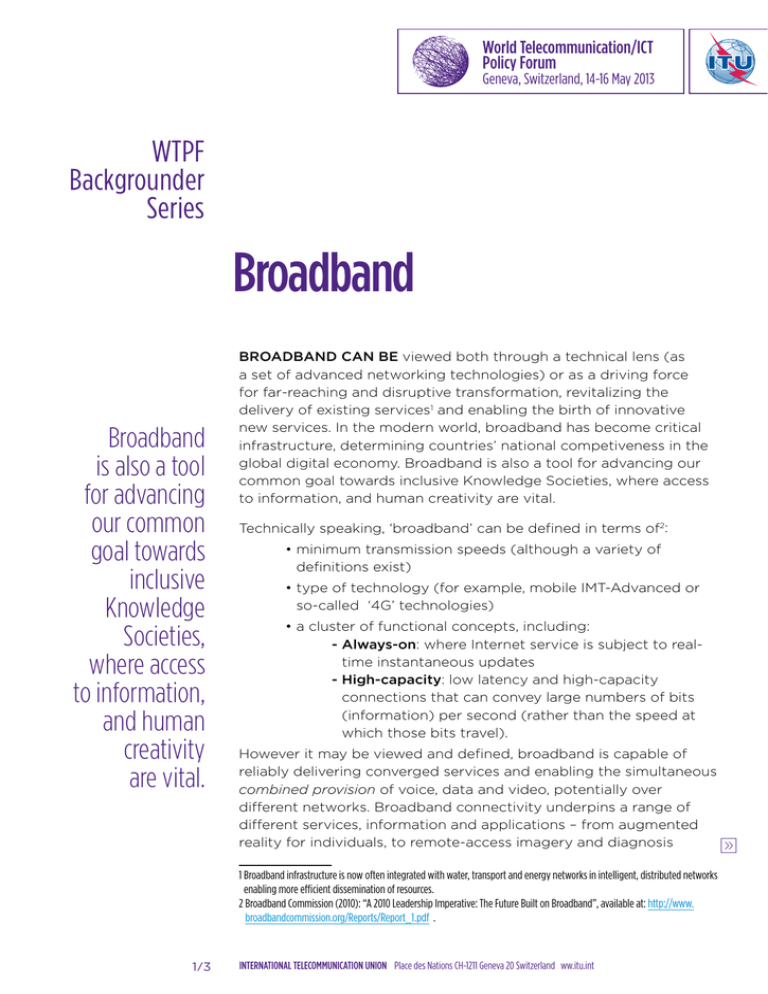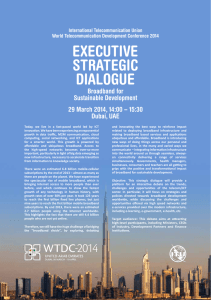Broadband WTPF Backgrounder Series
advertisement

World Telecommunication/ICT Policy Forum Geneva, Switzerland, 14-16 May 2013 WTPF Backgrounder Series Broadband Broadband is also a tool for advancing our common goal towards inclusive Knowledge Societies, where access to information, and human creativity are vital. Broadband can be viewed both through a technical lens (as a set of advanced networking technologies) or as a driving force for far-reaching and disruptive transformation, revitalizing the delivery of existing services1 and enabling the birth of innovative new services. In the modern world, broadband has become critical infrastructure, determining countries’ national competiveness in the global digital economy. Broadband is also a tool for advancing our common goal towards inclusive Knowledge Societies, where access to information, and human creativity are vital. Technically speaking, ‘broadband’ can be defined in terms of2: •m inimum transmission speeds (although a variety of definitions exist) • t ype of technology (for example, mobile IMT-Advanced or so-called ‘4G’ technologies) •a cluster of functional concepts, including: - Always-on: where Internet service is subject to realtime instantaneous updates -H igh-capacity: low latency and high-capacity connections that can convey large numbers of bits (information) per second (rather than the speed at which those bits travel). However it may be viewed and defined, broadband is capable of reliably delivering converged services and enabling the simultaneous combined provision of voice, data and video, potentially over different networks. Broadband connectivity underpins a range of different services, information and applications – from augmented reality for individuals, to remote-access imagery and diagnosis 1 Broadband infrastructure is now often integrated with water, transport and energy networks in intelligent, distributed networks enabling more efficient dissemination of resources. 2 Broadband Commission (2010): “A 2010 Leadership Imperative: The Future Built on Broadband”, available at: http://www. broadbandcommission.org/Reports/Report_1.pdf . 1/3 International telecommunication union Place des Nations CH-1211 Geneva 20 Switzerland ww.itu.int » WTPF Backgrounder Series World Telecommunication/ICT Policy Forum Geneva, Switzerland, 14-16 May 2013 » in medicine, distributed computing tasks in academic research, interactive remote online classrooms in education – and much more not yet dreamed of. Future service delivery in health, education, banking, business, trade and government will all rely on broadbandenabled platforms, so each and every country should plan for ‘a future built on broadband’. Just as broadband enables new services and industries, broadband is transforming established industries and legacy regulatory frameworks at breakneck pace. A new networked world is being built, based on converged NextGeneration Networks (NGN), but embracing concepts of embedded ambient intelligence, automated Machine to Machine (M2M) traffic, and the ‘Internet of Things’ (IoT). In our future networked world, users will enjoy high-speed connectivity on the move, roaming seamlessly between networks wherever they go – anywhere, anytime, via any device. Just as broadband enables new services and industries, broadband is transforming established industries and legacy regulatory frameworks at breakneck pace: •N ewspapers have moved to become online content providers •V oice over Internet Protocol (VoIP) has revolutionized the market for voice communications •T he music industry is working to innovate new revenue models •T he copyright industry faces fresh challenges in protecting intellectual property online. And the disruptive power of broadband does not just stop there. Today, a single piece of software or innovative device can: •C reate a new market (for example, as eBay created a global market-place for online auctions) •T ake an existing market online (for example, e-books and online music stores) •C ombine existing markets into a converged market in the digital age (for example, smartphones have successfully united a mobile phone with a digital camera with a music player and online Internet access for information and entertainment). Broadband is today available in virtually every country of the world. Early concerns about the ‘digital divide’ or inequality in the distribution 2/3 International telecommunication union Place des Nations CH-1211 Geneva 20 Switzerland ww.itu.int » WTPF Backgrounder Series World Telecommunication/ICT Policy Forum Geneva, Switzerland, 14-16 May 2013 » There are today 2.6 billion Internet users and 1.2 billion mobile broadband subscriptions worldwide. of Internet access or equipment in different countries3 have given way to more recent concerns about the need to avoid creating digital divides in speed or quality of access – not just in the developing world, but in countries worldwide.4 Because broadband will be the key delivery mechanism for a host of essential services, multi-stakeholder groups like the UN Broadband Commission for Digital Development is actively encouraging every country to prioritize the roll-out of high-speed fixed and mobile networks through National Broadband Plans, to support their long-term economic growth prospects and competitiveness in the information age.5 Research suggests that ICTs and broadband Internet have grown fastest where markets have been opened up to competition.6 There are today 2.6 billion Internet users and 1.2 billion mobile broadband subscriptions worldwide,7 with some three-quarters of the world’s population now having access to a mobile phone8. In 2011, the number of networked devices first exceeded the global population. By 2020, the number of connected devices could outnumber connected people by six to one,9 transforming our concept of the Internet, as well as our society, forever. It is in this spirit, and in view of this evidence, that the World Telecommunication/ICT Policy Forum (WTPF) 2013 presents its draft opinion on Fostering an enabling environment for the greater growth and development of broadband connectivity. 3 ICT Development Index, UNCTAD, 2003 and 2004. 4 World Information Society Reports 2006 and 2007, ITU/UNCTAD, Geneva, 2012. 5 “A 2010 Leadership Imperative: The Future Built on Broadband”, ITU/UNESCO Broadband Commission for Digital Development, available at: http://www.broadbandcommission.org/Reports/Report_1.pdf 6 See ITU “World Telecommunication Development Report 2002: Reinventing Telecoms”: http://www.itu.int/ITU-D/ict/publications/wtdr_02/ and ITU “Trends in Telecommunication Reform Report 2007: The Road to NGN”: http://www.itu.int/ITU-D/treg/ publications/trends07.html. 7 ICT Facts and Figures 2012, ITU (2012) and http://www.itu.int/ITU-D/ict/statistics/at_glance/keytelecom.html 8 “Information and Communications for Development Report 2012: Maximizing Mobile” World Bank (2012). 9 ITU Chapter in the Global IT Report 2012, “Issues in a Hyperconnected World” published by the World Economic Forum. DISCLAIMER This document is intended as a backgrounder to WTPF-13 to support media in their reporting. It should not be considered an official document of the conference. For further information please contact pressinfo@itu.int. 3/3 International telecommunication union Place des Nations CH-1211 Geneva 20 Switzerland ww.itu.int
